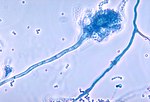This article has multiple issues. Please help improve it or discuss these issues on the talk page. (Learn how and when to remove these template messages)
|

Mold health issues refer to the harmful health effects of molds ("moulds" in British English) and their mycotoxins. However, recent research has shown these adverse health effects are caused not exclusively by molds, but also other microbial agents and biotoxins associated with dampness, mold, and water-damaged buildings, such as gram-negative bacteria that produce endotoxins, as well as actinomycetes and their associated exotoxins.[1] Approximately 47% of houses in the United States have substantial levels of mold, with over 85% of commercial and office buildings found to have water damage predictive of mold.[2] As many as 21% of asthma cases may result from exposure to mold.[3] Substantial and statistically significant increases in the risks of both respiratory infections and bronchitis have been associated with dampness in homes and the resulting mold.[4]
Molds and many related microbial agents are ubiquitous in the biosphere, and mold spores are a common component of household and workplace dust. While the most molds in the outdoor environment are not hazardous to humans, many found inside buildings are known to be and affect indoor air quality. Reaction to molds can vary between individuals, from relatively minor allergic reactions through to severe multi-system inflammatory effects, neurological problems, and death.[5][6]
Mold spores and associated toxins can cause harm primarily via inhalation, ingestion, and contact. In higher quantities such as those found in water-damaged buildings, they can present especially hazardous health risks to humans after sufficient exposure, with three generally accepted mechanisms of harm and a fourth probable mechanism:
- Allergic reactions, including allergic bronchopulmonary aspergillosis
- Invasive mold infections (mycosis)[7]
- Toxicity (poisoning by mycotoxins)[8]
- Innate immune dysfunction.[9]
- ^ Cite error: The named reference
:2was invoked but never defined (see the help page). - ^ "Prevalence of Building Dampness | Indoor Air Quality". Lawrence Berkeley National Laboratory. Retrieved 22 August 2022.
- ^ Mudarri D, Fisk WJ (June 2007). "Public health and economic impact of dampness and mold". Indoor Air. 17 (3): 226–235. Bibcode:2007InAir..17..226M. doi:10.1111/j.1600-0668.2007.00474.x. PMID 17542835. S2CID 21709547.
- ^ Fisk WJ, Eliseeva EA, Mendell MJ (November 2010). "Association of residential dampness and mold with respiratory tract infections and bronchitis: a meta-analysis". Environmental Health. 9 (1): 72. Bibcode:2010EnvHe...9...72F. doi:10.1186/1476-069X-9-72. PMC 3000394. PMID 21078183.
- ^ Orton K (25 October 2013). "Mold: What every homeowner fears but probably shouldn't". The Washington Post. Retrieved 16 April 2019.
- ^ Empting LD (2009). "Neurologic and neuropsychiatric syndrome features of mold and mycotoxin exposure". Toxicology and Industrial Health. 25 (9–10): 577–81. Bibcode:2009ToxIH..25..577E. doi:10.1177/0748233709348393. PMID 19854819. S2CID 27769836.
- ^ Bush RK, Portnoy JM, Saxon A, Terr AI, Wood RA (February 2006). "The medical effects of mold exposure". The Journal of Allergy and Clinical Immunology. 117 (2): 326–33. doi:10.1016/j.jaci.2005.12.001. PMID 16514772.
- ^ "Indoor Environmental Quality: Dampness and Mold in Buildings". National Institute for Occupational Safety and Health. 1 August 2008.
- ^ Cite error: The named reference
:7was invoked but never defined (see the help page).

